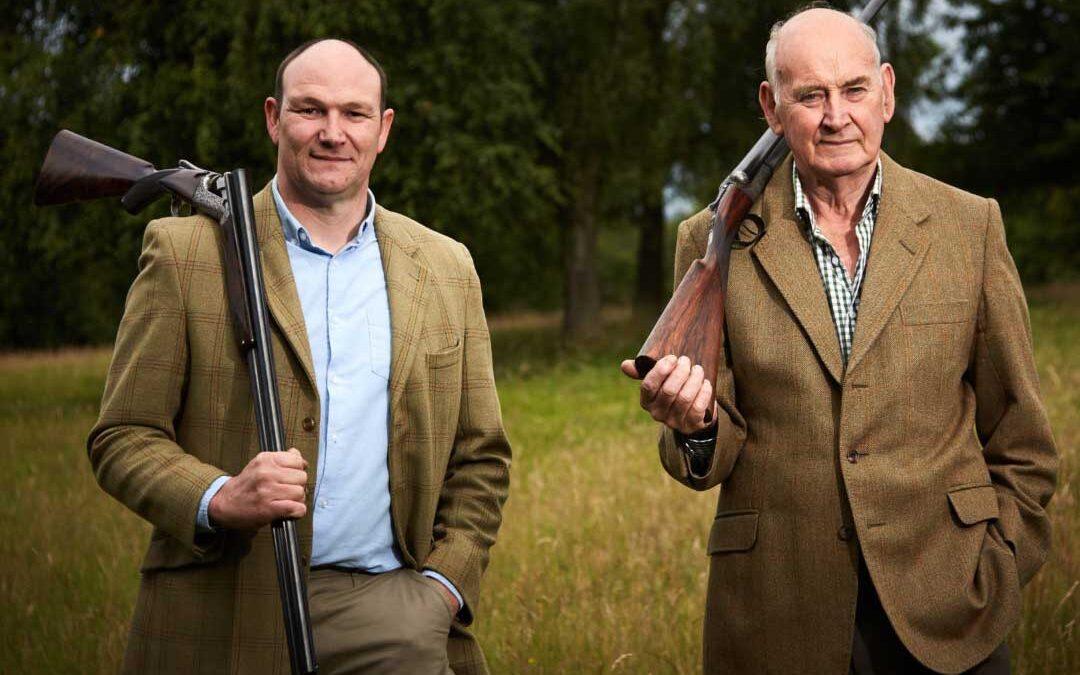It all started with an introduction by an English gentleman to two Scotsmen who would thankfully bring a huge sigh of relief to those of us who carried the torch for Scotland’s iconic round-action shotgun.
At the time, a 42-year-old Scottish gunsmith named Grant Buchan had succeeded in building a thriving business based in rural Mill of Rora near Peterhead, Aberdeenshire, Scotland.
After years of accumulating an encyclopedic knowledge of English shotguns, Grant decided the time had come to fulfill his own dream of building a bespoke all-Scottish, limited-production shotgun, settling on a cap of no more than 10 per year to ensure excellence and distinction. The masterpiece Grant envisioned would bear the family name, the Buchan, with his flagship model, the Balmoral over/under, starting at $129,000.
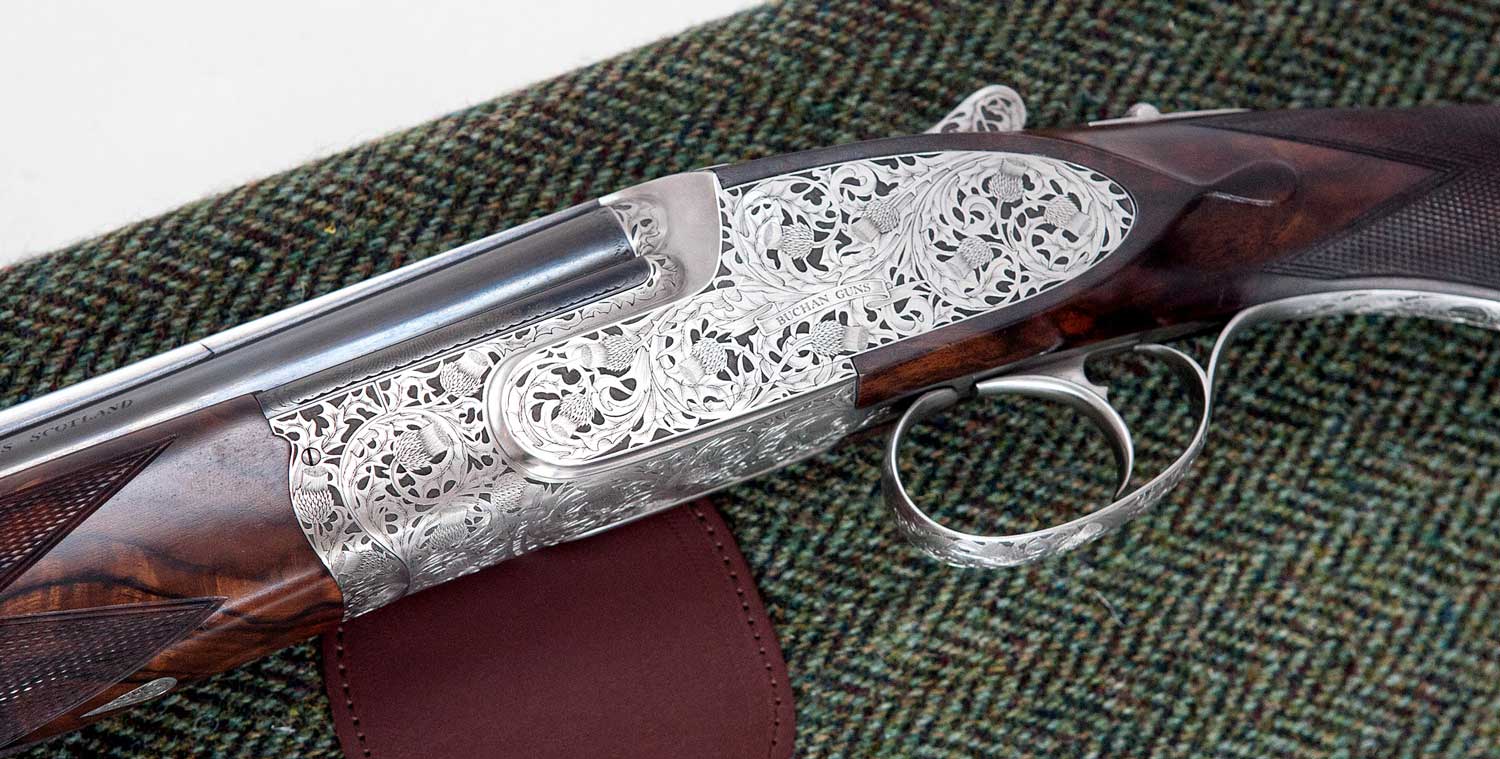
A Buchan Balmoral 12-gauge.
Having shot a Balmoral in 28 gauge, I became absolutely convinced that Grant was a gunmaking virtuoso who most certainly possessed the chops to resurrect the revered marque of an Edinburgh round-action shotgun, McKay Brown. The shuttering of McKay Brown in 2020 had been a blow to devotees who delighted in the graceful lines and intuitive dynamics of David McKay Brown’s uniquely Scottish over/under.
While we would like to harbor the romantic notion that Grant’s resurrection of McKay Brown was a selfless act of Scottish pride, in fact it was a business decision that, in the corporate vernacular, would prove to be a win-win situation. Grant’s know-how and drive had served as the impetus for the first meeting in Scotland of the fine firearms triumvirate—Grant, David McKay Brown and Guy Bignell—with the intention of turning the lights on again in the cramped, sealed workshop at 32 Hamilton Road, Bothwell, Glasgow, Scotland, that David and his four artisans had occupied from 1980 to 2020.
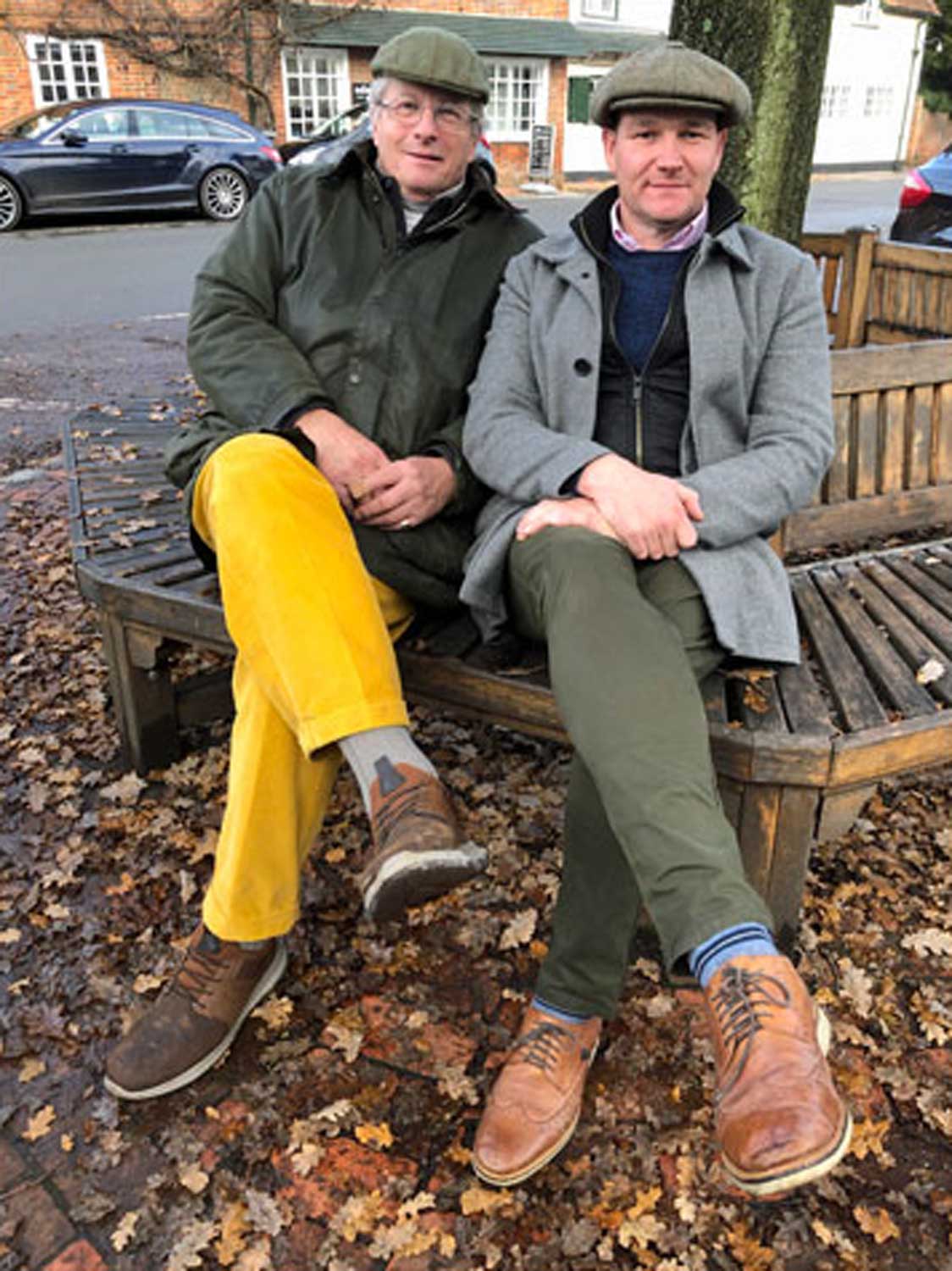
Guy Bignell and Grant Buchan.
I wasn’t alone in my assessment of Grant. There was also Englishman Guy Bignell, the 71-year-old former CEO of the legendary American gunmaker and retailer, Griffin & Howe. A year or so before, Guy had relinquished his day-to-day management responsibilities for semi-retirement in Taylors, South Carolina. But as the saying goes, you can’t keep a good man down. He continued focusing on his passion for selling fine guns and rifles for the company.
While Guy remained immersed in the world of established European firearms, he also maintained his personal mission of acquainting Americans with star-quality boutique gunmakers from across the pond as he had done since 1999 with gunmakers such as Blaser, Longthorne, William & Son and Kemen.
“In fact, it’s very difficult to succeed in the gun trade,” he told me. “My mantra is to do my best to move young companies in the right direction. I just enjoy mentoring up-and-coming people in the gun trade.”
Guy’s relationship with Buchan Guns started when he was still working at Griffin & Howe’s Hudson Farm in Andover, New Jersey. In February 2019, phone calls and emails to Griffin & Howe from somebody in Scotland were passed along to Guy. Apparently, a gunsmith named Grant Buchan wanted the prestigious firearm concern to represent his eponymous new seven-pin, sidelock-ejector shotguns in America.
Naturally, Guy was receptive to talking with him. Grant delivered an in-depth description of his Balmoral, including the claim that he made every component in-house except for the barrels (as of April 2024, however, Buchan installed barrel-making machinery and now delivers shotguns that are 100-percent Scottish-made except when customers request international engravers).
Guy was skeptical of Grant’s claim about an all-Scottish shotgun. He knew of companies in Europe and Turkey that covertly supplied parts to premium gunmakers whose success and legacies rested on their reputation for homegrown craftsmanship. “My response to Grant was, yeah sure, you make all those parts yourself.”
Still, Guy was sufficiently intrigued by his conversations with Grant to catch a flight to Scotland for a first-hand look. Upon visiting Buchan Guns, Guy examined the entire facility, plus met Grant’s family. Guy went through each stage of manufacturing, and ultimately confirmed that Grant had indeed made every single part of a Buchan shotgun except, at the time, the barrels.
“Grant is an amazing engineer,” Guy said in our conversation. “When he’s at his bench, he’s making these parts from scratch to fit each Buchan—all of that is unheard of in the trade.”
Guy’s visit to Buchan Guns was followed by a trip with Grant through the Netherlands, Belgium, Switzerland, England and Italy where they met with engravers and Turkish-walnut stock suppliers.
During that trip, their mentorship evolved into friendship, where common interests and values form a deeper bond. Respect grows as the individuals recognize each other’s strengths, values and perspectives. And, as with the best of friendships, a deep sense of trust developed.
“When we were together flying around and visiting companies, a point of conversation was that Grant couldn’t survive financially making eight to 10 Buchans per year,” Guy recalled. “I told him, you’re going to need more money than you think. You ought to have another business. You need another brand you can run alongside Buchan.”
The idea had been planted for Grant to revive McKay Brown.
Several weeks after their barnstorming trip, Grant had sent a 12-gauge and a 28-gauge Buchan Balmoral to Guy for a due-diligence inspection. Guy handed off the guns to Paul Chapman, Griffin & Howe’s vice president and director of gunsmithing. Paul’s team examined the guns and gave them the “green light,” according to Guy. The shotguns were also evaluated by Griffin & Howe’s head shooting instructor, Kevin Sterk, who, as Guy described, “gave them two thumbs up.”
In the end, Griffin & Howe decided to represent Buchan Guns in the U.S.
As Buchan Guns’ star was beginning to rise, David McKay Brown, now in his late 70s, was planning to sail into the sunset. His self-imposed retirement at the age of 80 was within sight. An extremely shrewd businessman, David always turned a handsome profit on McKay Brown. When it came to the ledger books, inevitable comparisons were always drawn with the likes of British best-gunmakers Holland & Holland and James Purdey & Sons who seemed to chronically struggle financially, even after their purchases by Swiss conglomerate Richemont (Purdey) and French luxury perfumery, Chanel (Holland & Holland was subsequently bought by Beretta in 2021).
David had been interested in selling McKay Brown as he approached retirement, but under one stipulation: the new owner must be a Scotsman. Rather than capitulate to the French, Brits or any other globalists, and without a single Scotsman ready, willing and able to carry on the McKay Brown legacy, David completed the last 15 gun orders and padlocked the door to his time-worn shop—concluding his reign as heir to the fabled Edinburgh round-action shotgun.
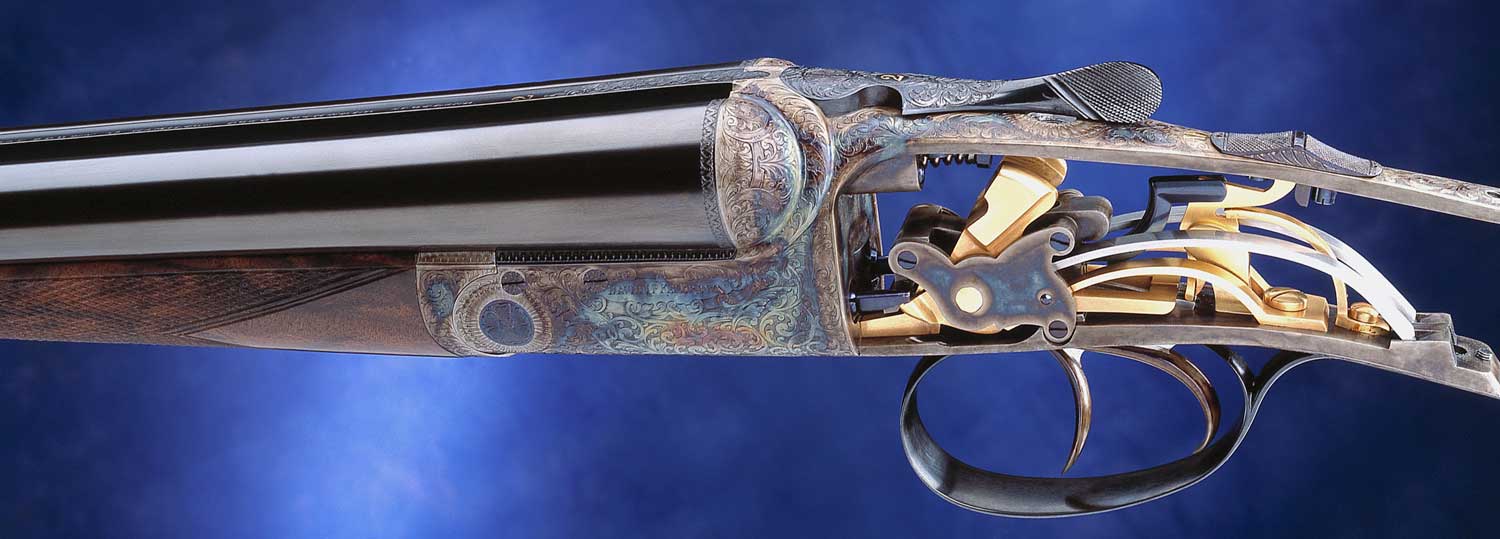
While some break-open shotguns may draw praise and envy for their Bulino engraving, exhibition-grade Turkish walnut or graceful profiles, the round-action shotgun is a sensual expression of the gunmaker’s art realized through its organic womanly shape of a softly curved bottom and svelte dimensions. The origins of the Scottish round-action, though, are actually rooted in the school of Scottish pragmatism based on its applicability in real-world problem solving, none better than grouse shooting.
In the mid-1800s, when the Glorious Twelfth heralded the opening of red grouse season in Scotland, hunters would arrive by train, horseback and carriages lugging their 7-pound side-by-sides with 30-inch barrels. Red grouse are notorious speed demons, clocking speeds of up to 70 miles per hour—presenting eyeball-spinning low-flying feathered missiles coming straight at you. Perhaps with the exception of the delightful Boss and Woodward over/unders appearing in the early 1900s, conventional side-by-sides coming out of Birmingham and London were better suited for the feet-planted, measured shooting of plump high pheasants. But since peatlands covered some 20 percent of Scotland, the Brits didn’t have as ready access to those sultry peaty single malts that got the brightest gunmakers ruminating on the creation of a nimble, light and harmonious grouse gun of some six pounds that would showcase the pride of Scottish ingenuity and craftsmanship.
The design and patents of the Scottish round-action recorded as of 1879 are attributed to two Edinburgh gunmakers, James MacNaughton and John Dickson & Son. An innovative action placed over the triggers with a lever-cocking mechanism allowed for a low-profile and graceful round-edged receiver that brought to bear the ergonomics and performance better suited for game birds born with a biological afterburner. The shotguns by MacNaughton and Dickson went on to epitomize the shape of the Edinburgh round-action side-by-side that remains largely unchanged today.
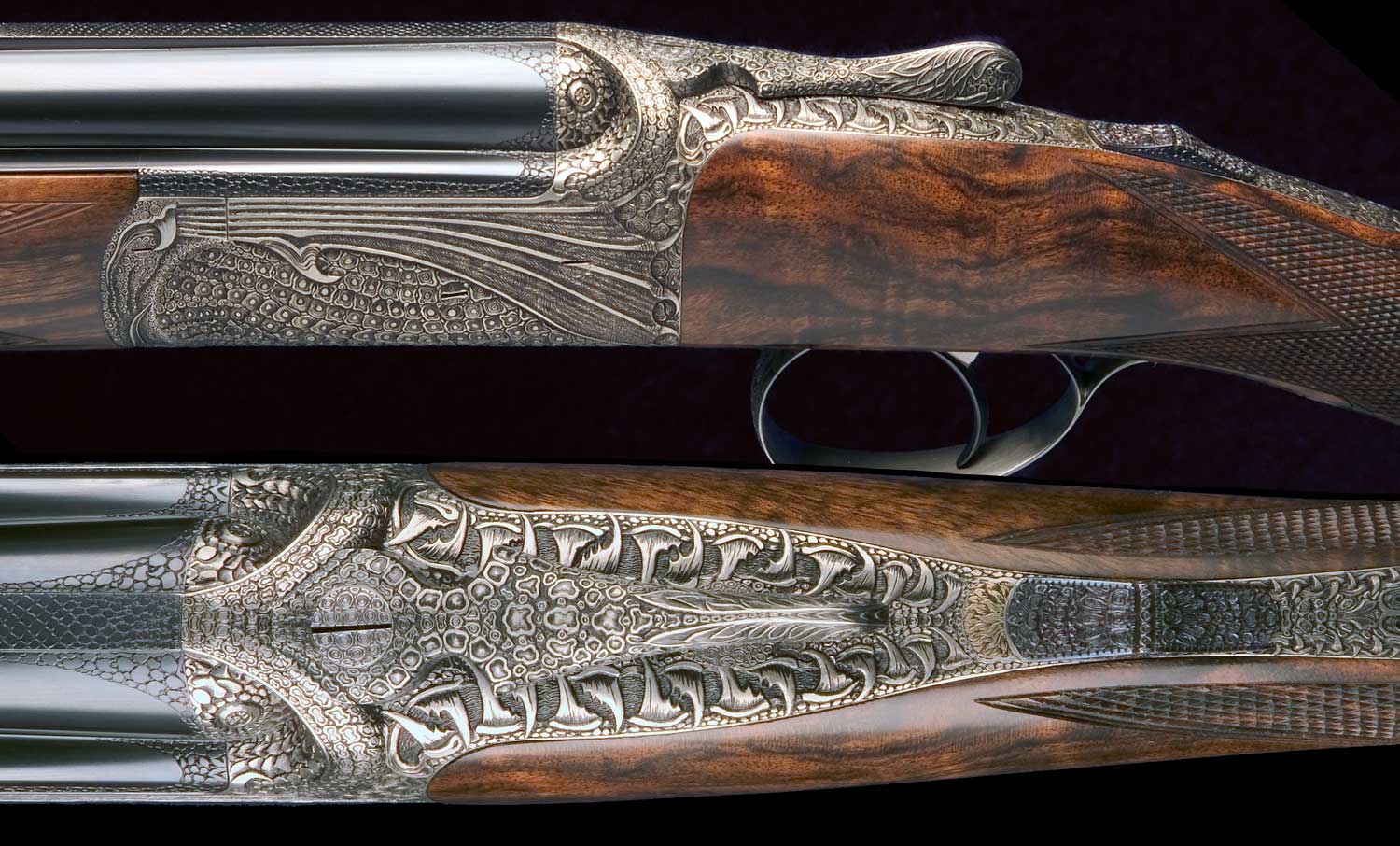
Elaborate engraving art on a David McKay Brown shotgun.
But it wasn’t until 1992 when David stunned the sporting set with McKay Brown number 7501—a gorgeous and elegant 12-gauge round-action over/under featuring a single trigger and “full cover medium scroll” by David Lee, as documented in Donald Dallas’ seminal coffee-table book David McKay Brown—Scotland’s Gun and Rifle Manufacturer.
That milestone was reached exactly 100 guns later than McKay Brown’s first shotgun, the number 7401 12-gauge side by side from 1974. Gun number 7501 appeared as David’s breakout statement among UK gun racks jammed with provincial side-by-sides. Ultimately, from the company’s inception in 1967, McKay Brown would produce nearly 1,200 round-action guns and rifles from his modest shop.
Ever the sly one, David liked clients to think that his guns were manufactured in-house. Among the trade, however, he was well-known for employing outside craftsmen who supplied various components. David also became an early adopter of digital CNC equipment to manufacture most parts to help cut manufacturing costs and improve efficiency. Between the outsourcing and CNC mills, David was able to shorten production times and increase profits.
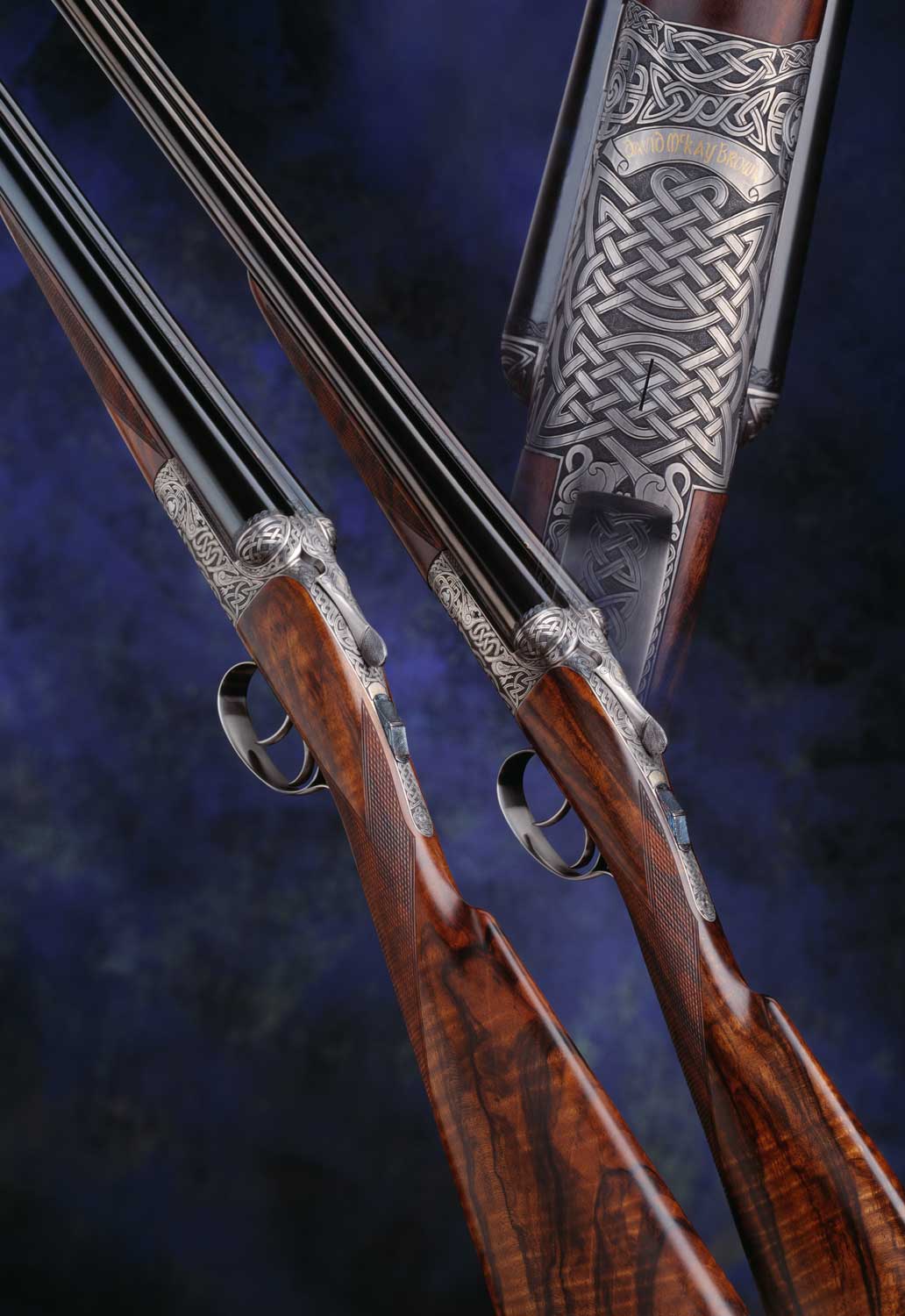
You can call it coincidence or perhaps kismet, but there seemed a certain inevitability that it would be Grant who brought McKay Brown back from the dead. Despite their age difference, Grant and David came up through the gunmaking ranks the traditional way, serving apprenticeships in the Scottish gun trade.
For Grant, while most of his friends played football after school in Longside, he popped into the local gunsmith shop owned by Eric Burnett, who became a teacher and inspiration. At the same time, Grant studied mechanical engineering at Aberdeen Technical College. To start his own gunsmithing operation, the Buchans sold their family business. Eric Burnett was one of Grant’s first hires among his initial four employees.
David’s apprenticeship started in 1958 at Alex Martin of Glasgow. He quickly rose to the position of foreman. By 1960, John Dickson & Son, synonymous with the Scottish round action, had acquired Alex Martin. David’s immersion into the Dickson round actions “had a big influence” on him, wrote Dallas.
David left after his 5-year apprenticeship and became an estate deer stalker—a short-lived career because he rejoined Dickson. He played a key role in growing their gun repair business and, as an incentive, was assured a share of the profits. When it came time to pay him, management withdrew the offer. David countered by asking for a £4 weekly raise, but instead was tendered only £2. As the breadwinner of a young family, Dickson’s response was untenable.
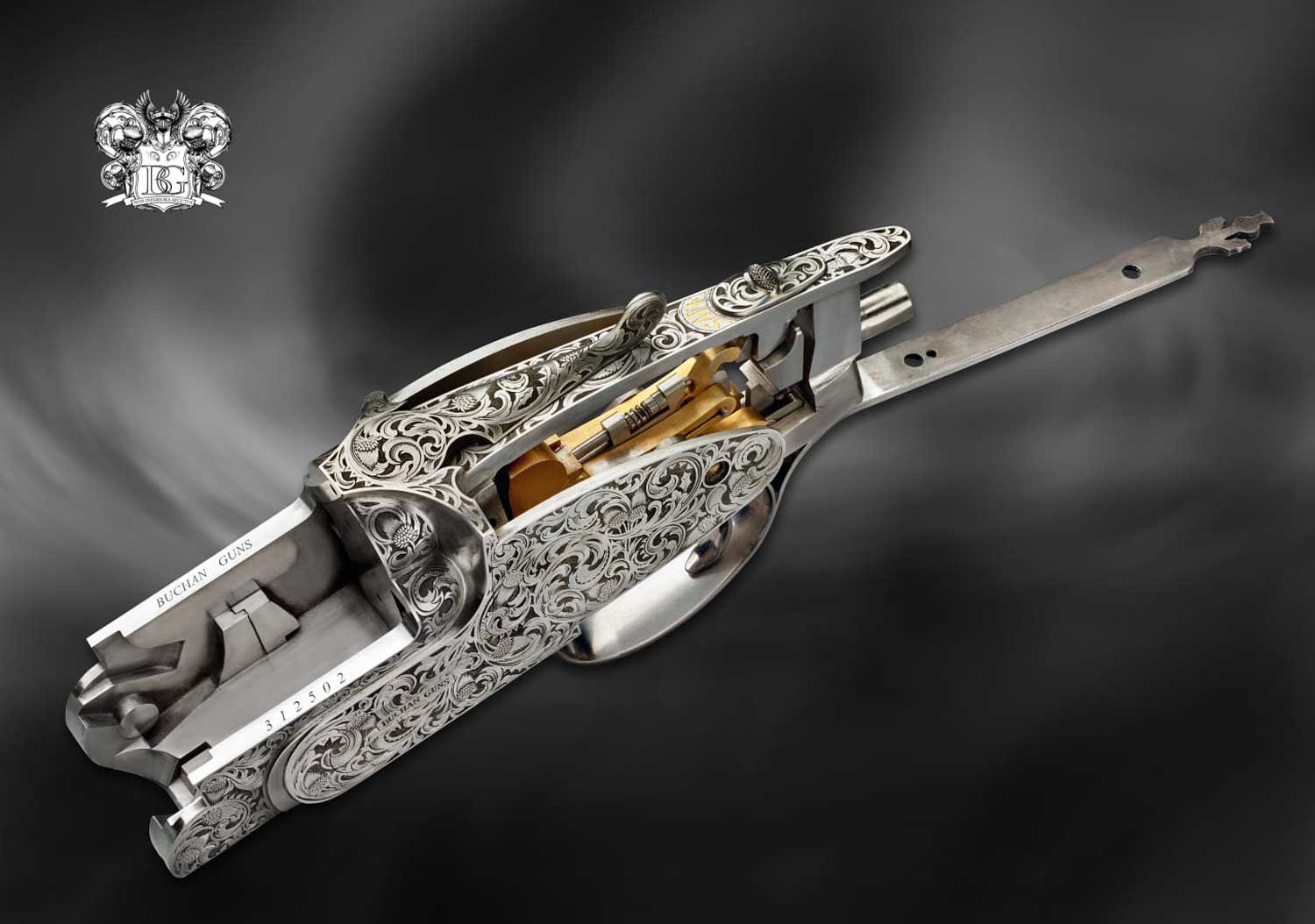
A Scottish round-action trigger-plate lock.
In 1967, he left Dickson to set up his first gunsmithing business near Glasgow, in a store that had previously served fish and chips. Come 1974, gun number 7401 marked the first McKay Brown. Nearly 30 years later, riding the success of his round-action over/under, David would accumulate a 4-year waiting list at a second facility located on 32 Hamilton Road. By now, a McKay Brown over/under round action would cost about twice the average London side-by-side, yet customers didn’t mind waiting years to get their hands on one. In the end, after the last orders were filled, David closed his company that was now down from four to two employees.
“I told Grant that I had a friend who retired from the gunmaking business in Scotland who was very popular, and his name is David McKay Brown,” Guy recounted. “I said let’s set up lunch with David because he’s no longer making guns, and people liked buying McKay Browns and wanted to continue to buy them. David’s business was one of the few gun businesses, certainly in the UK and England, that was making a significant profit.”
The lunch, in 2020, was preceded by a visit to the McKay Brown shop. Of that visit, Grant told me, “There was an old lathe, a barrel-honing machine and a small milling machine. The building was rundown, and it was about 60 square feet.”
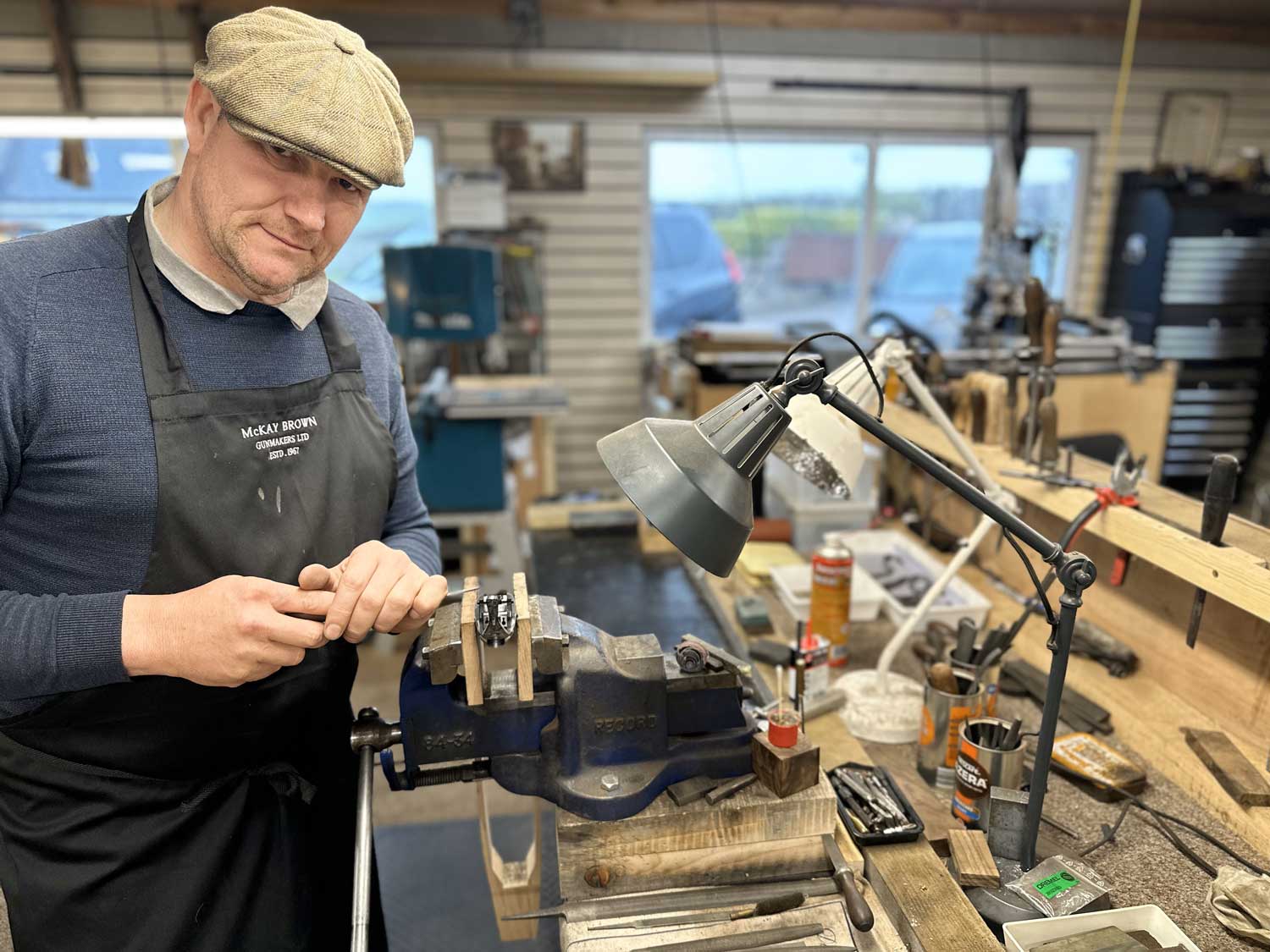
Grant at the bench of McKay Brown.
Afterward, the four men went to the Cricklewood restaurant across the road for a “general chit-chat,” as Grant described their lunch. That meeting led to the discussions culminating in Buchan’s acquisition of McKay Brown. The deal was announced on July 31, 2021. Grant basically got a few tools, a mailing list, right to the name and the ability to hire the four tradesmen who had spent their careers with McKay Brown.
Under Buchan, McKay Brown will continue in production of making 20 to 30 guns per year.
Grant had set up a new facility in the village of Kilmarnock, near the original McKay Brown Bothwell workshop, as a convenience for the men who had worked there (who combined have close to 150 years of experience with the company).
“David’s facilities wouldn’t be good for us,” Grant explained. “We went ahead and opened a new facility about 15 minutes from there. It was an existing industrial unit, and it was for David’s employees. While David was relying on three or four contractors to do his machinery work, we now have all those capabilities in-house with multiple advanced CNC centers, barrel making and lots of other different technologies, which will raise the standard of quality significantly.”
The McKay Brown components will be made in Buchan’s main Ugie Lodge factory, and then sent back to Bothwell where the guns will be assembled in the “traditional way,” Grant said. Afterward, the shotguns are returned to Ugie Lodge for stocking and regulation. Proofing will continue in London.
Currently, about 60 percent of McKay Browns are over/unders, with the balance side-by-sides.
“All the guns are bespoke, we make nothing for stock,” Grant said.
“The two people I put together liked each other, felt they could do well together,” Guy told me. “It was certainly a marriage in the making.”

